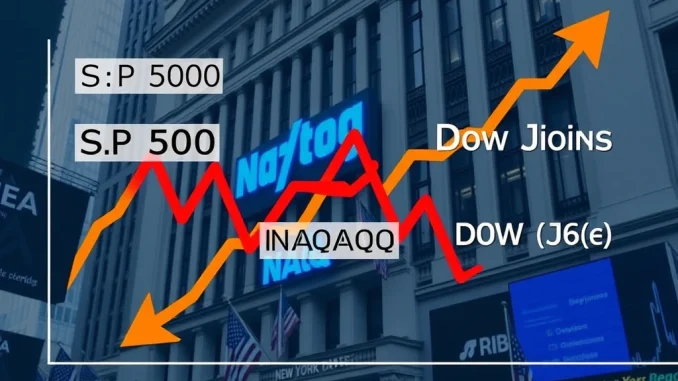
Buckle up, market watchers! The U.S. stock market bell has rung, and it’s signaling a mixed bag of signals right from the get-go. Investors are navigating a choppy sea as key indices paint a varied picture in the early hours of trading. Let’s break down what’s happening on Wall Street and what these initial movements could mean for the broader financial landscape.
Decoding the US Stock Market Open: A Mixed Performance
As the opening bell echoed, the three major U.S. stock indices embarked on divergent paths. Here’s a snapshot of how they’re faring:
- S&P 500: Experiencing a dip, currently down by 0.40%. This broad market index reflects a cautious sentiment among investors.
- NASDAQ: Bucking the trend slightly, the tech-heavy NASDAQ is in positive territory, up by a modest 0.12%. This suggests some resilience or perhaps continued interest in technology stocks.
- Dow Jones Industrial Average: Facing the steepest decline among the three, the Dow is down by a significant 0.79%. This index, composed of established blue-chip companies, indicates potential pressure on more traditional sectors.
To get a clearer picture, let’s visualize these opening movements in a table:
| Index | Performance |
|---|---|
| S&P 500 | -0.40% |
| NASDAQ | +0.12% |
| Dow Jones | -0.79% |
Why the Volatility at the Stock Market Open?
Several factors could be contributing to this mixed and somewhat volatile start to the trading day. Understanding these drivers is crucial for investors looking to navigate the current market landscape. Here are a few key elements at play:
- Economic Data Jitters: Recent economic data releases, such as inflation figures, employment reports, or consumer spending data, can heavily influence market sentiment. Uncertainty or mixed signals from these indicators often lead to investor caution and varied market reactions.
- Interest Rate Speculation: The Federal Reserve’s stance on interest rates is always a major market mover. Any hints or expectations regarding future rate hikes or pauses can trigger significant shifts in investor behavior.
- Sector-Specific News: News impacting specific sectors, like technology, energy, or financials, can create divergence among indices. Positive news for tech might lift the NASDAQ while negative news in industrials could weigh down the Dow.
- Global Events: Geopolitical tensions, international economic developments, and global market trends can also spill over and impact U.S. stock market performance.
S&P 500: Navigating a Cautious Path
The S&P 500‘s slight decline reflects a broad-based hesitancy across various sectors. As the most comprehensive index, the S&P 500’s performance often mirrors the overall market sentiment. Investors are likely assessing a range of factors, from corporate earnings to macroeconomic forecasts, leading to this initial downturn.
NASDAQ’s Tech Resilience in the Stock Market
The NASDAQ‘s positive start, albeit modest, points to continued strength or investor confidence in the technology sector. This could be driven by positive earnings reports from tech companies, optimism about future growth in technology, or simply a rotation of funds into growth-oriented stocks. However, it’s important to note that this positive movement is still tentative and could shift as the trading day progresses.
Dow Jones Under Pressure: Examining the Decline
The Dow Jones‘s more pronounced drop suggests that traditional, blue-chip companies are facing headwinds. This could stem from concerns about economic slowdown impacting established industries, sector-specific challenges, or a rotation away from value stocks towards growth. The Dow’s performance warrants close attention as it can be indicative of broader economic concerns.
Actionable Insights for Investors
In this mixed market environment, what steps can investors consider?
- Stay Informed: Keep a close watch on economic news, corporate earnings releases, and global market developments. Real-time information is crucial for making informed decisions.
- Diversification is Key: A diversified portfolio can help mitigate risks during volatile periods. Spreading investments across different sectors and asset classes can cushion the impact of market swings.
- Long-Term Perspective: Avoid knee-jerk reactions to short-term market fluctuations. Maintain a long-term investment strategy and focus on your overall financial goals.
- Seek Professional Advice: If you’re unsure how to navigate the current market, consider consulting with a financial advisor who can provide personalized guidance.
Conclusion: Navigating the Uncertain Stock Market Landscape
The U.S. stock market’s mixed open underscores the prevailing uncertainty in the current economic climate. While the NASDAQ shows pockets of strength, the S&P 500 and Dow Jones are facing initial headwinds. Investors need to remain vigilant, informed, and adaptable as they navigate this dynamic and somewhat volatile market environment. The day is still young, and market sentiment can shift rapidly, so staying tuned to further developments is paramount for making sound investment decisions.



